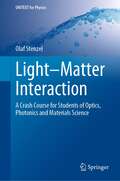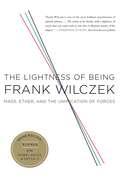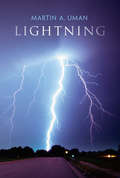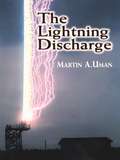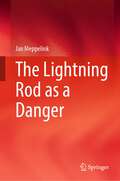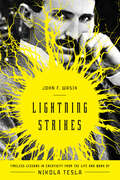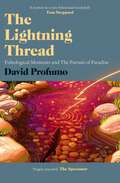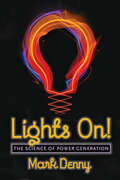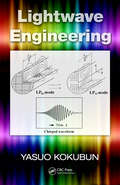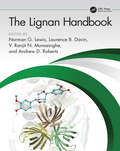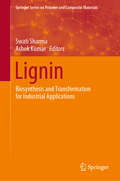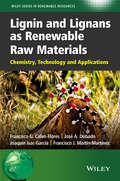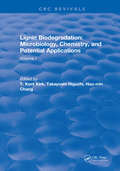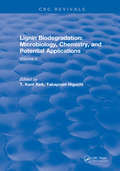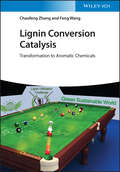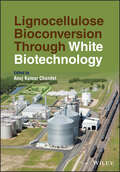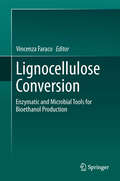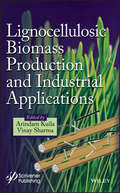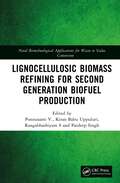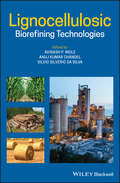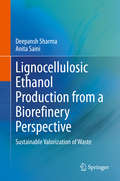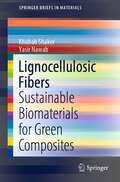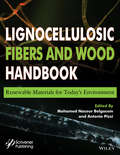- Table View
- List View
Light–Matter Interaction: A Crash Course for Students of Optics, Photonics and Materials Science (UNITEXT for Physics)
by Olaf StenzelThis book offers a didactic introduction to light–matter interactions at both the classical and semi-classical levels. Pursuing an approach that describes the essential physics behind the functionality of any optical element, it acquaints students with the broad areas of optics and photonics. Its rigorous, bottom-up approach to the subject, using model systems ranging from individual atoms and simple molecules to crystalline and amorphous solids, gradually builds up the reader’s familiarity and confidence with the subject matter. Throughout the book, the detailed mathematical treatment and examples of practical applications are accompanied by problems with worked-out solutions. In short, the book provides the most essential information for any graduate or advanced undergraduate student wishing to begin their course of study in the field of photonics, or to brush up on important concepts prior to an examination.
The Lightness of Being: Mass, Ether, and the Unification of Forces
by Frank WilczekOur understanding of nature's deepest reality has changed radically, but almost without our noticing, over the past twenty-five years. Transcending the clash of older ideas about matter and space, acclaimed physicist Frank Wilczek explains a remarkable new discovery: matter is built from almost weightless units, and pure energy is the ultimate source of mass. He calls it "The Lightness of Being." Space is no mere container, empty and passive. It is a dynamic Grid-a modern ether- and its spontaneous activity creates and destroys particles. This new understanding of mass explains the puzzling feebleness of gravity, and a gorgeous unification of all the forces comes sharply into focus.The Lightness of Being is the first book to explore the implications of these revolutionary ideas about mass, energy, and the nature of "empty space." In it, Wilczek masterfully presents new perspectives on our incredible universe and envisions a new golden age of fundamental physics.
Lightning: Fire From The Sky (Dover Books on Physics #Volume 39)
by Martin A. UmanAwesome to any beholder, lightning has been a subject of intense interest to scientists curious about its exact physical nature. There was a dearth of comprehensive scientific literature on the subject until the publication of this volume. Geared toward advanced undergraduates in physics or engineering, it features remarkable clarity and a minimum of mathematical notation, making it accessible to nonspecialists and useful as a teaching resource or for self-study. Dr. Uman, whose own work has contributed greatly to understanding the physics of lightning, presents a general introduction to lightning phenomena and terminology, lightning photography, electrical and magnetic field measurements, and current measurements. Additional topics include lightning spectroscopy and thunder, a wealth of new and detailed analyses of the latest data, and reviews of theories regarding the discharge process from the special vantage point of a scientist well-versed in plasma physics. Five appendices bring recent research up to date, covering such phenomena as bead and ball lightning and reviewing experimental data and modeling. This authoritative exposition of the many physical phenomena associated with lightning is the only inexpensive single-volume presentation on the subject.
Lightning
by Martin A. Uman Vladimir A. RakovComplete and comprehensive, this text for advanced undergraduates in physics and engineering features exceptional clarity and minimum of mathematic notation. Topics include lightning phenomena and terminology, lightning photography, lightning spectroscopy, electrical and magnetic field measurements and current measurements, and more. 140 figures and tables.
The Lightning Discharge
by Martin A. UmanIn this readable, absorbing, up-to-date monograph, one of the nation's foremost experts on lightning sets forth most of what has been learned about the subject. To make the material more easily understandable, the author has organized the chapters primarily by lightning process. Following a general introduction and chapters on lightning phenomenology and cloud and lightning charges, he looks into the types and stages of lightning, with chapters on the stepped leader, the attachment process, the return stroke, the dart leader, continuing current, J- and K-processes in discharges to the ground, positive lightning, upward lightning and the artificial initiation of lightning, and cloud discharges. In the final two chapters, Dr. Uman investigates lightning on other planets and examines the phenomenon of thunder.Each chapter contains a reference list, and the book as a whole is augmented with a generous selection of diagrams, charts, and photographs. Appendices on electromagnetics, statistics, and experimental techniques help to clarify some of the concepts covered in the text. A fourth appendix lists relevant books. Of special interest to physicists, meteorologists, and electrical engineers, the newly corrected edition of this detailed study offers a deep understanding of one of nature's most intriguing phenomena. 144 illustrations. Appendices. Index.
The Lightning Rod as a Danger
by Jan MeppelinkThis book investigates the physical effects of a lightning flash on a person near the down conductor of a lightning protection system. These effects are the touch voltage, the step voltage and the side flash. For this purpose, a full-scale simulation model of the human body with a resistance of 1000 ohms was first created. In the simulation model, the body can touch the down conductor or be placed close to it. Furthermore, the specific resistance of the earth is varied. Likewise, insulating layers such as asphalt can be incorporated into the simulation model. Also, special cases like water permeable layers or water layers on an asphalt layer can be calculated. In post-processing, all relevant values can be determined, such as the energy converted in the body, the charge, the current and the voltage applied to the body. A comparison with the permissible limit values then shows for the lightning protection classes whether there is danger or not and provides information on necessary measures. There is a risk for death and injury if the down conductor is touched. However, there is also a risk of a side flash if a person is standing next to a discharge. Site isolation with dry asphalt is effective, but there is a residual risk of surface discharges. In real situations with wet asphalt, water-permeable layers or asphalt with a water layer, however, there is a great risk of death or injury. Equipotential bonding with an earthing grid is a necessary but not sufficient solution with regard to the induced voltage at negative subsequent stroke. Therefore, the situation must always be examined on a case-by-case basis with regard to the safety requirements. The only effective measure to prevent injury and death due to touch voltage is an insulating down conductor in conjunction with equipotential bonding. The measures for reducing the touch voltage, such as site insulation and equipotential bonding, basically also apply to limiting the step voltage. A risk calculation according to IEC 62305-2 gives the mean time between two events of injury and death MG = 1/RA. The tolerable risk is: RA = 0,0001 or MT = 10.000 years, equivalent to one death in 10.000 years.
Lightning Strikes: Timeless Lessons in Creativity from the Life and Work of Nikola Tesla
by John F. WasikAn exploration of the scientist’s inspiring life, his controversies, his legacy, and how his creativity can help us today.Seventy years after his death, Nikola Tesla has become a rock star. Lightning Strikes examines his complete life and legacy, including Tesla’s profound influence on everything from systems integration to drone warfare. Engineers, entrepreneurs, and academics will find it invaluable not only for the never-before-published interviews and archives, but also for the creative principles that visionaries like Larry Page and Elon Musk have used to build iconic brands and groundbreaking inventions. The book also reveals why the government and business leaders wanted to shut down Tesla’s bold experiments, and how hundreds of his ideas are now being implemented globally—including clean power, robotics, alternating current motors, and wireless transmission of power and information.As a bonus, a free augmented reality app from Yetzer Studio allows you to scan beautiful full-color illustrations in the book, unlocking an interactive 3D animation as well as videos honoring Tesla's life and legacy.
The Lightning Thread: Fishological Moments and The Pursuit of Paradise
by David ProfumoFrom award winning novelist and journalist David Profumo comes a dazzling work about the restorative power of nature and finding joy in simple pleasures. The Lightning Thread takes the reader on a journey of unexpected delight, personal pleasure and profound discovery. From angling with his father on a spating burn at the height of the Profumo Affair to knocking back mojitos while hunting for Permit, &‘the Robocop of the sea&’, off the coast of Cuba. Much more than just another book about fishing, The Lightning Thread is an exploration of joy and a celebration of simple pleasures in a too complicated world. The significance of angling, as David writes about it, far transcends the mere catching of fish. It is about the extraordinary places he has visited, the remarkable people he has met and the great happiness pursuing his life&’s passion has brought him. Written with warmth, wit and lightly worn erudition, his references range from Ted Hughes to Wittgenstein, from W.C. Fields to Milton, and always hovering in the background is the spectre of Isaak Walton&’s TheCompleat Angler, the Ur-text of halieutic literature. A work of the passionate eclecticism, deep intelligence and virtuosically exuberant prose from one of our finest writers, The Lightning Thread is a future classic and the culmination of lifetime's obsession.
Lights On!: The Science of Power Generation
by Mark DennyWatt’s up? A reader-friendly introduction to all things power.Power generation is a relatively recent concern because humans had little need for sustained power until the dawn of the Industrial Revolution. Today, modern civilization is wholly dependent on the production and distribution of power. Without it, our way of life would be extinguished.In Lights On!, Mark Denny reveals the mysterious world of power generation. He takes us on a fun tour, examining the nature of energy, tracing the history of power generation, explaining the processes from production through transmission to use, and addressing questions that are currently in the headlines, such as:• Is natural gas the best alternative energy source in the near term? • Could solar power be the answer to all our problems? • Why is nuclear power such a hard sell, and are the concerns valid?Devoting individual chapters to each of the forms of power in use today—electrical, coal, oil and natural gas, hydro, nuclear, and solar—Denny explains the pros and cons of each, their availability worldwide, and which are in dwindling supply. Making clear that his approach is that of "a scientist and engineer, not a politician or businessman," Denny addresses environmental concerns by providing information to help readers understand the science and engineering of power generation so they can discuss contemporary energy issues from an informed perspective. For those who wish to delve deeper into the science, a technical appendix provides estimations for a variety of power generators.Anyone who is interested in how energy works and how it is transformed to power our lives will get a charge out of Lights On!
Lightwave Engineering (Optical Science and Engineering)
by Yasuo KokubunSuitable as either a student text or professional reference, Lightwave Engineering addresses the behavior of electromagnetic waves and the propagation of light, which forms the basis of the wide-ranging field of optoelectronics. Divided into two parts, the book first gives a comprehensive introduction to lightwave engineering using plane wave and then offers an in-depth analysis of lightwave propagation in terms of electromagnetic theory. Using the language of mathematics to explain natural phenomena, the book includes numerous illustrative figures that help readers develop an intuitive understanding of light propagation. It also provides helpful equations and outlines their exact derivation and physical meaning, enabling users to acquire an analytical understanding as well. After explaining a concept, the author includes several problems that are tailored to illustrate the explanation and help explain the next concept. The book addresses key topics including fundamentals of interferometers and resonators, guided wave, optical fibers, and lightwave devices and circuits. It also features useful appendices that contain formulas for Fourier transform, derivation of Green's theorem, vector algebra, Gaussian function, cylindrical function, and more. Ranging from basic to more difficult, the book’s content is designed for easily adjustable application, making it equally useful for university lectures or a review of basic theory for professional engineers.
The Lignan Handbook
by Norman G. Lewis Laurence B. Davin V. Ranjit N. Munasinghe Andrew D. RobertsLignans are aromatic compounds isolated from plants. This handbook presents an authoritative and comprehensive review of lignan chemistry, biochemistry, nomenclature, uses, and occurrence. Lignans are used in a wide variety of industries and this book will appeal to those working in the pulp and paper industries, renewable energy, specialty chemicals, pharmaceuticals, flavors and fragrances, agriculture and forestry, evolution and ecology. Additionally, the book features a comprehensive lignans dictionary section, drawn from the prestigious Dictionary of Natural Products. Other features include: Presents a comprehensive and up-to-date account of this important group of natural products Addresses and resolves problems in current lignan nomenclature Edited by the leaders in the field of lignan chemistry and biochemistry
Lignin: Biosynthesis and Transformation for Industrial Applications (Springer Series on Polymer and Composite Materials)
by Ashok Kumar Swati SharmaThis book presents a comprehensive overview on origin, structure, properties, modification strategies and applications of the biopolymer lignin. It is organized into four themed parts. The first part focuses on the analysis and characterization of the second most abundant biopolymer. The following part is devoted to the biological aspects of lignin such as biosynthesis and degradation. In the third part, chemical modification strategies and the preparation of composites as well as nano- and microparticles are discussed.The final part addresses the industrial application of lignin and its derivatives, as well as lignin materials. The usage for synthesis of biofuels, fine chemicals and in agriculture and food industry is covered.This book is a comprehensive source for researchers, scientists and engineers working in the field of biopolymers as well as renewable materials and sources.
Lignin and Lignans as Renewable Raw Materials
by Francisco G. Calvo-Flores Joaquín Isac-García José A. Dobado Francisco J. Martín-MartínezAs naturally occurring and abundant sources of non-fossil carbon, lignin and lignans offer exciting possibilities as a source of commercially valuable products, moving away from petrochemical-based feedstocks in favour of renewable raw materials. Lignin can be used directly in fields such as agriculture, livestock, soil rehabilitation, bioremediation and the polymer industry, or it can be chemically modified for the fabrication of specialty and high-value chemicals such as resins, adhesives, fuels and greases. Lignin and Lignans as Renewable Raw Materials presents a multidisciplinary overview of the state-of-the-art and future prospects of lignin and lignans. The book discusses the origin, structure, function and applications of both types of compounds, describing the main resources and values of these products as carbon raw materials. Topics covered include: * Structure and physicochemical properties* Lignin detection methods* Biosynthesis of lignin* Isolation methods* Characterization and modification of lignins* Applications of modified and unmodified lignins * Lignans: structure, chemical and biological properties* Future perspectives This book is a comprehensive resource for researchers, scientists and engineers in academia and industry working on new possibilities for the application of renewable raw materials. For more information on the Wiley Series in Renewable Resources, visit www.wiley.com/go/rrs
Lignin Biodegradation: Volume I
by T.K. KirkFirst Published in 2018. Routledge is an imprint of Taylor & Francis, an Informa company.
Lignin Biodegradation: Volume II
by T.Kent. KirkLignin is a generic name for the complex aromatic polymers that are major components of vascular plant tissues. Lignin is abundant; in terms of weight it is probably second only to cellulose among renewable organic materials, and in terms of energy content it might well be the single most abundant. an international seminar on lignin biodegradation was organized and was held May 9 to 11, 1978, at the U.S. Forest Products Laboratory in Madison, Wisconsin. This book records the proceedings of that seminar and is meant to provide a summary of research. Each speaker/author was asked to summarize his research, including his latest unpublished results, and to describe how his work fits into the overall picture. Following two orientation chapters, one a review of lignin structure and morphological distribution in plant cell walls, and the second a review of the microbial catabolism of relevant aromatics, the book is comprised of chapters in the three subject areas given by the book's title. It does, as intended, provide comprehensive coverage of research to date (August 1978).
Lignin Conversion Catalysis: Transformation to Aromatic Chemicals
by Chaofeng Zhang Feng WangLignin Conversion Catalysis Authoritative reference providing comprehensive knowledge on the lignin conversion process with recent developments of mechanisms and techniques Lignin Conversion Catalysis: Transformation to Aromatic Chemicals covers the strategy, catalysis, and mechanisms of cleaving lignin linkages to aromatic chemicals and crucially elaborates on the specifics of multiple original lignins. Sample topics covered in the work include: Lignin depolymerization, models, and techniques of various lignins by heterogeneous substrates (such as native lignins, Kraft lignins, and organosolv lignins) Cleavage methods for lignins (such as oxidation and hydrogenation) as well as their main products (such as arenes, phenol, and acid) Relationships among the strategy/method, catalyst, and mechanism when viewed from the cleavage order and the type of corresponding chemical bonds Commercial components of lignin, a globally available raw material with many applications in drug design, polymers, and more Organic chemists, polymer chemists, and chemical engineers can use the valuable information contained in Lignin Conversion Catalysis: Transformation to Aromatic Chemicals to get up to date on this new raw material and understand the various developments that have been made in the field to make it viable for industrial purposes.
Lignocellulose Bioconversion Through White Biotechnology
by Anuj Kumar ChandelLignocellulose Bioconversion Through White Biotechnology Comprehensive resource summarizing the recent technological advancements in white biotechnology and biomass conversion into fuels, chemicals, food, and more Lignocellulose Bioconversion Through White Biotechnology presents cutting-edge information on lignocellulose biomass conversion, detailing how white biotechnology can develop sustainable biomass pretreatment methods, effective plant cell wall degrading enzymes to yield high quality cellulosic sugars, and the eventual conversion of these sugars into fuels, chemicals, and other materials. To provide comprehensive coverage of the subject, the work offers in-depth critical analysis into both techno-economic and life cycle analysis of lignocellulose-based products. Each of the 16 chapters, written by a well-qualified and established researchers, academics, or engineers, presents key information on a specific facet of lignocellulose-based products. Topics covered include: Lignocellulose feedstock availability, types of feedstock, and potential crops that are of high interest to the industry Lignocellulose bioconversion, including both foundational technical aspects and new modern developments Plant cell wall degrading enzymes, including cellulase improvement and production challenges/solutions when scaling up Improvements and challenges when considering fermenting microorganisms for cellulosic sugars utilization Scaling up of lignocellulose conversion, including insight into current challenges and future practices Techno-economic aspects of lignocellulose feedstock conversion, green consumerism and industrialization aspects of renewable fuels/chemicals Students, academics, researchers, bio-business analysts, and policy-makers working on sustainable fuels, chemicals, materials, and renewable fuels can use Lignocellulose Bioconversion Through White Biotechnology to gain invaluable expert insight into the subject, its current state of the art, and potential exciting future avenues to explore.
Lignocellulose Conversion
by Vincenza FaracoBioethanol has been recognized as a potential alternative to petroleum-derived transportation fuels. Even if cellulosic biomass is less expensive than corn and sugarcane, the higher costs for its conversion make the near-term price of cellulosic ethanol higher than that of corn ethanol and even more than that of sugarcane ethanol. Conventional process for bioethanol production from lignocellulose includes a chemical/physical pre-treatment of lignocellulose for lignin removal, mostly based on auto hydrolysis and acid hydrolysis, followed by saccharification of the free accessible cellulose portions of the biomass. The highest yields of fermentable sugars from cellulose portion are achieved by means of enzymatic hydrolysis, currently carried out using a mix of cellulases from the fungus Trichoderma reesei. Reduction of (hemi)cellulases production costs is strongly required to increase competitiveness of second generation bioethanol production. The final step is the fermentation of sugars obtained from saccharification, typically performed by the yeast Saccharomyces cerevisiae. The current process is optimized for 6-carbon sugars fermentation, since most of yeasts cannot ferment 5-carbon sugars. Thus, research is aimed at exploring new engineered yeasts abilities to co-ferment 5- and 6-carbon sugars. Among the main routes to advance cellulosic ethanol, consolidate bio-processing, namely direct conversion of biomass into ethanol by a genetically modified microbes, holds tremendous potential to reduce ethanol production costs. Finally, the use of all the components of lignocellulose to produce a large spectra of biobased products is another challenge for further improving competitiveness of second generation bioethanol production, developing a biorefinery.
Lignocellulosic Biomass Production and Industrial Applications
by Arindam Kuila Vinay SharmaLignocellulosic Biomass Production and Industrial Applications describes the utilization of lignocellulosic biomass for various applications. Although there have been numerous reports on lignocellulosic biomass for biofuel application, there have been very few other applications reported for lignocellulosic biomass-based chemicals and polymers. Therefore, this book covers all of the possible lignocellulosic biomass applications. Besides describing the different types of biofuel production, such as bioethanol, biobutanol, biodiesel and biogas from lignocellulosic biomass, it also presents various other lignocellulosic biomass biorefinery applications for the production of chemicals, polymers, paper and bioplastics. In addition, there are chapters on valorization of lignocellulosic materials, alkali treatment to improve the physical, mechanical and chemical properties of lignocellulosic natural fibers, and a discussion of the major benefits, limitations and future prospects of the use of lignocellulosic biomass.
Lignocellulosic Biomass Refining for Second Generation Biofuel Production (Novel Biotechnological Applications for Waste to Value Conversion)
by Ponnusami V.This book compiles research aspects of second generation (2G) biofuel production specifically sourced from lignocellulose biomass with the direction of biorefinery means. It focusses on the valorization of different sources of 2G biofuels and their relative importance. The constituents of lignocelluloses and their potential characteristics, end utilization of biofuel from production are discussed. Different means of treatments of lignocellulose through physical, physio-chemical, microbial, and enzymatic approaches are also included. Features: Describes technological advancements for bioethanol production from lignocellulosic waste. Provides the roadmap for the production and utilization of 2G Biofuels. Introduces the strategic role of metabolic engineering in the development of 2G biofuels. Discusses technological advancements, life cycle assessment, and prospects. Explores the novel potential lignocellulosic biomass for 2G biofuels. This book is aimed at researchers and professionals in renewable energy, biofuel, bioethanol, lignocellulose conversion, fermentation, and chemical engineering.
Lignocellulosic Biorefining Technologies
by Anuj Kumar Chandel Avinash P. Ingle Silvio Silv?rio da SilvaA text to the advances and development of novel technologies in the production of high-value products from economically viable raw materials Lignocellulosic Biorefining Technologiesis an essential guide to the most recent advances and developments of novel technologies in the production of various high-value products from economically viable raw materials. Written by a team of experts on the topic, the book covers important topics specifically on production of economical and sustainable products such as various biofuels, organic acids, enzymes, biopigments, biosurfactants, etc. The book highlights the important aspects of lignocellulosic biorefining including structure, function, and chemical composition of the plant cell wall and reviews the details about the various components present in the lignocellulosic biomass and their characterizations. The authors explore the various approaches available for processing lignocellulosic biomass into second generation sugars and focus on the possibilities of utilization of lignocellulosic feedstocks for the production of biofuels and biochemicals. Each chapter includes a range of clear, informative tables and figures, and contains relevant references of published articles. This important text: Provides cutting-edge information on the recent developments in lignocellulose biorefinery Reviews production of various economically important and sustainable products, such as biofuels, organic acids, biopigments, and biosurfactants Highlights several broad-ranging areas of recent advances in the utilization of a variety of lignocellulosic feedstocks Provides a valuable, authoritative reference for anyone interested in the topic Written for post-graduate students and researchers in disciplines such as biotechnology, bioengineering, forestry, agriculture, and chemical industry, Lignocellulosic Biorefining Technologies is an authoritative and updated guide to the knowledge about various biorefining technologies.
Lignocellulosic Ethanol Production from a Biorefinery Perspective: Sustainable Valorization of Waste
by Deepansh Sharma Anita SainiThis book provides an overview of the multi-dimensional approach for the production of ethanol from lignocellulosic biomass. The sustainability of this biofuel, the current and future status of the technology and its role in waste valorization are also addressed.Bioethanol from lignocellulosic material has emerged as an alternative to the traditional first-generation bioethanol. The book also discusses various pretreatment methods for effective separation of the various components of lignocellulosic feedstock as well as their advantages, and limitations. It describes the valorization of lignocellulosic waste through the production of bioethanol and emphasizes the significance of waste utilization in managing the production cost of the fuel. Finally, the utilization of genetically engineered plants and microorganisms to increase the conversion efficiency is reviewed.
Lignocellulosic Fibers: Sustainable Biomaterials for Green Composites (SpringerBriefs in Materials)
by Khubab Shaker Yasir NawabThe book is primarily focused on natural plant (lignocellulosic) fibers as sustainable reinforcement material for green composites. It begins with a brief introduction to common plant-based reinforcements, their extraction techniques, the structure of plant fibers, and describes novel fibers extracted from fruit, seeds, leaf, bast, and agricultural waste. The book then focuses on the application of these fibers as reinforcements for composite materials, covering reinforcement and composite fabrication techniques, as well as their performance evaluation. Overall, the book provides a unique and comprehensive look at lignocellulosic fibers for use in green composites, appealing to both researchers in the area of sustainable materials and industry professionals and entrepreneurs interested in their utilization in value-added composite products.
Lignocellulosic Fibers and Wood Handbook: Renewable Materials for Today's Environment
by Naceur Belgacem Antonio PizziThis book will focus on lignocellulosic fibres as a raw material for several applications. It will start with wood chemistry and morphology. Then, some fibre isolation processes will be given, before moving to composites, panel and paper manufacturing, characterization and aging.
